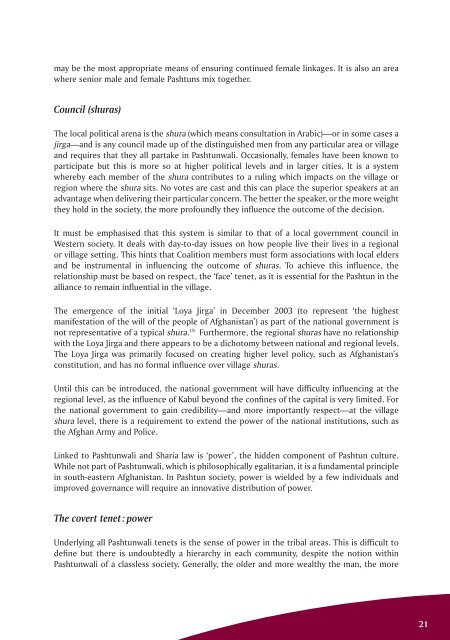ISSUE 180 : Nov/Dec - 2009 - Australian Defence Force Journal
ISSUE 180 : Nov/Dec - 2009 - Australian Defence Force Journal
ISSUE 180 : Nov/Dec - 2009 - Australian Defence Force Journal
- No tags were found...
Create successful ePaper yourself
Turn your PDF publications into a flip-book with our unique Google optimized e-Paper software.
may be the most appropriate means of ensuring continued female linkages. It is also an areawhere senior male and female Pashtuns mix together.Council (shuras)The local political arena is the shura (which means consultation in Arabic)—or in some cases ajirga—and is any council made up of the distinguished men from any particular area or villageand requires that they all partake in Pashtunwali. Occasionally, females have been known toparticipate but this is more so at higher political levels and in larger cities. It is a systemwhereby each member of the shura contributes to a ruling which impacts on the village orregion where the shura sits. No votes are cast and this can place the superior speakers at anadvantage when delivering their particular concern. The better the speaker, or the more weightthey hold in the society, the more profoundly they influence the outcome of the decision.It must be emphasised that this system is similar to that of a local government council inWestern society. It deals with day-to-day issues on how people live their lives in a regionalor village setting. This hints that Coalition members must form associations with local eldersand be instrumental in influencing the outcome of shuras. To achieve this influence, therelationship must be based on respect, the ‘face’ tenet, as it is essential for the Pashtun in thealliance to remain influential in the village.The emergence of the initial ‘Loya Jirga’ in <strong>Dec</strong>ember 2003 (to represent ‘the highestmanifestation of the will of the people of Afghanistan’) as part of the national government isnot representative of a typical shura. 19 Furthermore, the regional shuras have no relationshipwith the Loya Jirga and there appears to be a dichotomy between national and regional levels.The Loya Jirga was primarily focused on creating higher level policy, such as Afghanistan’sconstitution, and has no formal influence over village shuras.Until this can be introduced, the national government will have difficulty influencing at theregional level, as the influence of Kabul beyond the confines of the capital is very limited. Forthe national government to gain credibility—and more importantly respect—at the villageshura level, there is a requirement to extend the power of the national institutions, such asthe Afghan Army and Police.Linked to Pashtunwali and Sharia law is ‘power’, the hidden component of Pashtun culture.While not part of Pashtunwali, which is philosophically egalitarian, it is a fundamental principlein south-eastern Afghanistan. In Pashtun society, power is wielded by a few individuals andimproved governance will require an innovative distribution of power.The covert tenet : powerUnderlying all Pashtunwali tenets is the sense of power in the tribal areas. This is difficult todefine but there is undoubtedly a hierarchy in each community, despite the notion withinPashtunwali of a classless society. Generally, the older and more wealthy the man, the more21
















